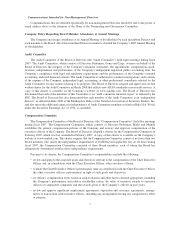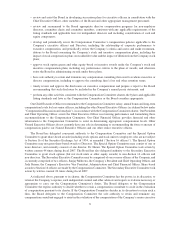SanDisk 2007 Annual Report Download - page 20
Download and view the complete annual report
Please find page 20 of the 2007 SanDisk annual report below. You can navigate through the pages in the report by either clicking on the pages listed below, or by using the keyword search tool below to find specific information within the annual report.In response to strong shareholder support for a majority vote standard in director elections, an increasing
number of the nation’s leading companies, including Intel, General Electric, Motorola, Hewlett-Packard, Morgan
Stanley, Wal-Mart, Home Depot, Gannett, Marathon Oil, and recently Pfizer have adopted a majority vote standard
in company bylaws or articles of incorporation. Additionally, these companies have adopted director resignation
policies in their bylaws or corporate governance policies to address post-election issues related to the status of
director nominees that fail to win election. Other companies have responded only partially to the call for change by
simply adopting post-election director resignation policies that set procedures for addressing the status of director
nominees that receive more “withheld” votes than “for” votes. At the time of this proposal submission, our
Company and its board had not taken either action.
We believe that a post-election director resignation policy without a majority vote standard in company bylaws or
articles is an inadequate reform. The first critical step in establishing a meaningful majority vote policy is the adoption of
a majority vote standard. With a majority vote standard in place, the board can then consider action on developing post-
election procedures to address the status of directors that fail to win election. A majority vote standard combined with a
post-election director resignation policy would establish a meaningful right for shareholders to elect directors, and
reserve for the board an important post-election role in determining the continued status of an unelected director. We feel
that this combination of the majority vote standard with a post-election policy represents a true majority standard.
SanDisk’s Statement in Opposition to Proposal No. 3
The Board of Directors believes this proposal does not serve the best interests of the Company or its
stockholders and recommends a vote AGAINST it.
This proposal requests that the Company initiate a process to amend its governance documents to provide a majority
voting standard for director elections so that stockholders have a “meaningful role in director elections.” However, we
believe that our strong corporate governance practices and director election process currently provide stockholders a
meaningful and important role in the election of directors. Like most large public companies incorporated in Delaware,
we currently use a plurality voting standard, the default standard under Delaware law, which provides that the nominees
who receive the most affirmative votes are elected to serve as our directors. We also provide stockholders with the ability
to express their preferences in the election of directors by cumulating their votes. As discussed below, cumulative voting,
which most public companies do not permit but is widely recognized as a corporate governance mechanism designed to
protect stockholders’ rights, gives our stockholders unique leverage in voting on the election of directors.
Cumulative Voting Provides Stockholders a Meaningful Role in the Director Election Process
Retaining the plurality vote standard is particularly advisable in the Company’s case because our stockholders
have the ability to express their preferences in the election of directors by cumulating their votes. Cumulative
voting, which most public companies do not allow but is universally recognized as protecting stockholders’ rights,
gives our stockholders unique leverage in voting on the election of directors. It allows each stockholder to cast all of
his or her available votes in director elections for a single director nominee, thereby enhancing the voting power of
minority stockholders. While the rules governing director elections are well understood when cumulative voting
rights are exercised under a plurality vote standard, cumulative voting under a majority vote standard presents
technical and legal issues for which there is almost no precedent.
The Company’s voting system must be a reliable process for the election of qualified directors to represent the
interests of all of our stockholders. In the absence of uniform, workable standards that can be consistently applied by
all companies and that take into account the special circumstances of companies with cumulative voting, the
Company believes it would be inappropriate to adopt a majority voting standard.
The Proposed Voting Standard is not Tailored to Address the Benefits to the Company’s Stockholders that
Result from Cumulative Voting
The proponent argues that under the plurality vote standard a director could be elected with “a single
affirmative vote, even if a substantial majority of the votes cast are ’withheld’ from the nominee.” However, that
remote, theoretical possibility does not accurately reflect the actual results experienced by the Company using
cumulative voting and a plurality standard for director elections. In the past three years, the Company’s directors
have, on average, received the affirmative vote of greater than 81% of the shares voted in director elections.
17
























